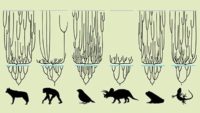Photosynthesis in plants starts with the absorption of light energy from sunlight, but scientists have been baffled as to how plants utilize the noisy solar spectrum to power the photosynthetic process. By applying engineering principles used to construct wireless antennae reception and energy transfer in human-designed systems, scientists uncovered an ingenious system of design for light harvesting in plants.1 Photosynt… More… …read more Source: icr.org
Is flight an easy trait to lose? …read more Source: creation.com
Data obtained from the Cassini space probe show that Saturn’s largest moon, Titan, is receding away from Saturn a hundred times faster than scientists previously thought.1,2 Titan is moving away from Saturn for basically the same reason that the moon is receding away from the Earth. The moon’s gravitational influence causes ocean tides on both sides of the Earth—the side nearest the moon and the side fa… More… …read more Source: icr.org
A new species of a split-footed lacewing was recently unearthed in British Columbia, Canada, creating a bit of controversy among secular paleontologists.1 All living relatives of this insect reside exclusively in Australia today.1 So, why are fossils of this insect found in Canada? Bruce Archibald of Simon Fraser University and Vladimar Makarkin of the Russian Academy of Sciences in Vladivostok tried to explai… More… …read more Source: icr.org
Two of the remotest places ever visited by humans are the moon and the deepest part of the ocean. Earth’s lowest point is called the “Challenger Deep,” a depression inside the southern end of the Mariana Trench—the deepest point in the western Pacific Ocean, located in the territorial waters of the Federated States of Micronesia, east of the Mariana Islands. Kelly Walsh, th… More… …read more Source: icr.org
By Rich Wendling God placed within small seeds an astonishing ability to move mountains, which even pyramid builders sought to imitate. …read more Source: AIG Daily
Is coronavirus the start of the end times? And if flat earth is wrong, why isn’t the entire universe backlit by stars? …read more Source: creation.com
This ‘dirty secret’ of modern-day Darwinism blows a hole in evolutionary theory a mile wide! …read more Source: creation.com
It actually speaks against Darwinism! …read more Source: creation.com
By Dr. Georgia Purdom Epigenetics, a field of science, displays the providence of God to help organisms adapt and survive in a fallen world which helps explain beneficial mutations. …read more Source: AIG Daily
Surprising catastrophism in sediments for uniformitarians; is it consistent with the Flood? …read more Source: creation.com
Recently, the issue of the moon’s motion away from Earth was discussed on a popular science website.1,2 The author of the article is a geologist who disputes the creationist claim that the moon’s gradual recession from the Earth is a problem for a solar system that is billions of years old. Laser-ranging experiments show that the moon is receding from Earth at the rate of 3.8 centimeters per year.3… More… …read more Source: icr.org
By Harry F. Sanders, III Phylogenetics, the proposed evolutionary history of a species (or group of species), ultimately fails because of flawed scientific and philosophical assumptions. …read more Source: AIG Daily
A recent study, from the University of Exeter in England, provides insight into how and why European pine martens need each other—but also like to keep their distance from each other. The research also covered how the presence of pine martens affects the behavior of local squirrels.1-3 European pine martens are weasel-sized, smaller than many domestic cats, and move about in woodlands. Many have tracked ranges that… More… …read more Source: icr.org
Wandering albatrosses have the largest wingspan of any living bird, so they live much of life soaring above the oceans. With their wings—and a lot of winds—it is no wonder that their use of wind-power would be studied by scientists, as a recent report illustrates.1,2 And, because albatross males are bigger, they need more wind. A new study of albatrosses has found that wind … More… …read more Source: icr.org
Chinese researchers recently reported on venomous toxins of the giant jellyfish. They revealed that this aquatic creature mixes a “cocktail” of toxins to produce stinging agony and sometimes death unto its victims.1,2 Jellyfish stings are a major threat to human beings in coastal areas of the world. Each year, hundreds of thousands of victims are stung by venomous jellyfish…. More… …read more Source: icr.org
Dolphins—like other cetaceans such as whales, wholphins, and porpoises—are highly intelligent marine mammals, capable of astonishing feats. A recent University of Leeds study, led by Sonja Wild, adds to what we humans have learned about what and how dolphins learn.1,2 Dolphins catch fish as prey by a mix of programmed instincts and learning.3,4 One example of learned fish-catching be… More… …read more Source: icr.org
By Troy Lacey Whale evolution is presented in most biology textbooks as absolute fact, often with inaccurate depictions of the supposed transitional forms. …read more Source: AIG Daily
A study led by Oxford University researchers was recently published confirming that Neanderthals and humans were very genetically similar and interfertile. They were even closer than polar and brown bears are to each other, which are known to mate and produce viable offspring in the wild quite easily.1 Along with a plethora of previous DNA studies, this research further confirms that Neanderthals were an ancient people group of the hum… More… …read more Source: icr.org
A total solar eclipse is an amazing phenomenon, and can illustrate biblical teachings …read more Source: creation.com
By Joel Ebert The slow loris’ large eyes have a reflective layer to help them see in almost total darkness. …read more Source: AIG Daily
A pair of new studies found that some dinosaurs, and possibly some marine reptiles, laid squishy eggs. One study discovered that many dinosaurs, like turtles and snakes, laid soft leather-like eggs—not hard-shelled eggs like most birds.1 A second study found a massive leathery egg about the size of a football in Cretaceous sediments in Antarctica.2 However, they think it was from a marine reptile and not a dinosaur.More… …read more Source: icr.org
Is it a safe and healthy practice to build using lots of timber, or not? Some French and Norwegian policy-makers say yes, while some British policy-makers disagree.1 The French support their enthusiasm for constructing buildings with lots of wood, assuming that doing so somehow helps save the planet from manmade global warming. They argue that “timber construction … [helps] trees lock up climate-heating carb… More… …read more Source: icr.org
By Ken Ham For hundreds of years, we’ve classified organisms according to the system developed by Carl Linnaeus. Organisms fall into various kingdoms, phyla, classes, orders, families, genera, and species. It’s a time-honored method of categorizing what God has made. But some scientists are trying to change this. As you can see, this new system of classification is entirely based on the evolutionary tree of life and the idea that all life had a common ancestor. As one popular science article begins, “Move over, Linnaeus: There’s a new way of naming organisms.” This new system is known as the PhyloCode [More]
By Ken Ham Our head of horticulture at the Ark Encounter told my wife, Mally, and me that the large firecracker plant (Vermillionaire Cuphea) was the best plant to attract hummingbirds, so my wife put one on our deck. It didn’t take long. While I was sitting on the deck, a beautiful female ruby-throated hummingbird—the only breeding hummingbird species in eastern North America—came up to the plant and I was able to snap a couple of photos with my smartphone. Worthy are you, our Lord and God, to receive glory and honor and power, for you created …read more Source: [More]
Once again, a scientific study shows how “farmed” or ranched creatures live better if their domesticated context resembles their natural habitat.1 According to a recent study published in Aquaculture Reports, confined fish at Brazilian farms raising Nile tilapia (Oreochromis niloticus), fared better if they had an assortment of shelter-like structures and/or artificial plants.2,3 As a fish that … More… …read more Source: icr.org


















![Center of My Joy [Live] Center of My Joy [Live]](http://img.youtube.com/vi/bIqDK4mRGlQ/0.jpg)



























